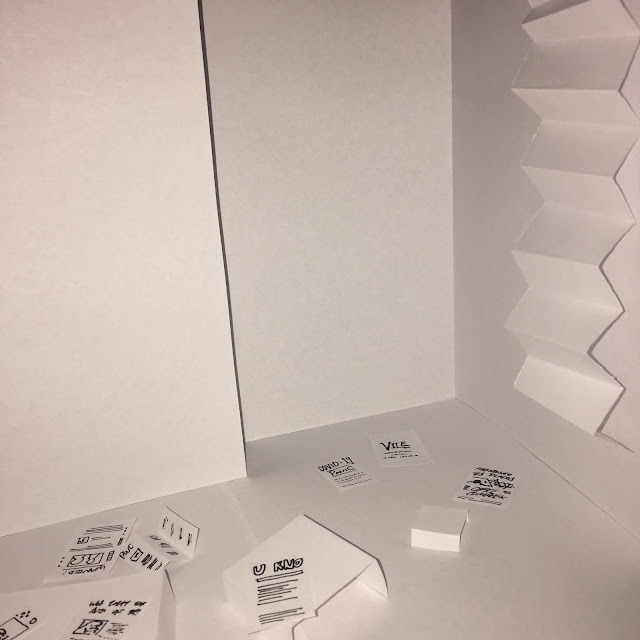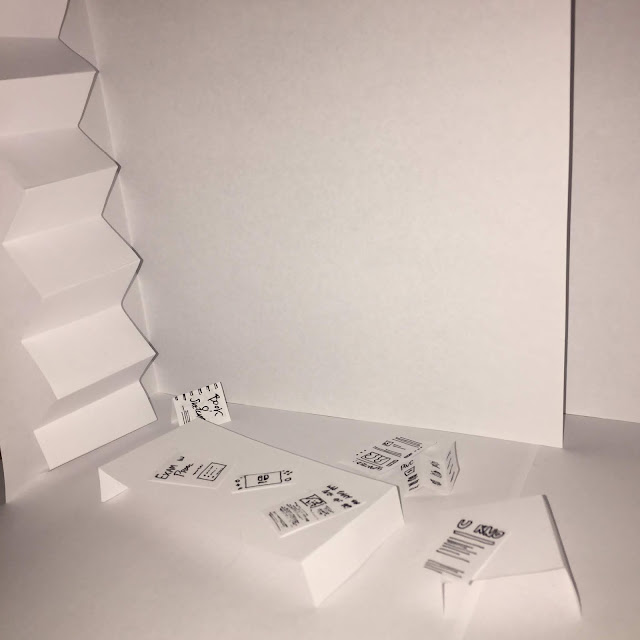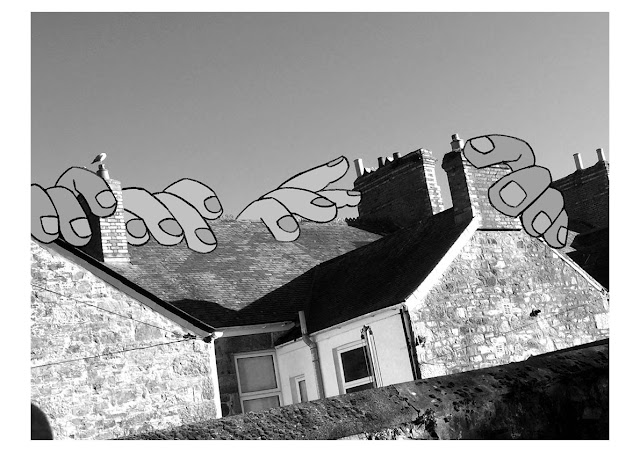After an hour or so of folding, cutting, scrunching and arranging paper, I have created numerous pieces, each of which have been dubbed with appropriate names. Some are recreations of existing pieces as showcased in my previous post, and others are the result of ideas popping into my head which were too good not to attempt to create.

This piece is titled "Ring", for a very obvious reason. What I did here was take a full A4 sheet of paper, lay it out landscape and scrunch it to form a long, jagged piece of scrunched paper. From there, I bent it inward to create about a 90° curve, photographed it from a bird's eye view, imported it into Photoshop, selected it, cut out the rest of the background, duplicated it, rotated it another 90° and joined up the ends, and repeated that once more to create a ring. The lighting, colour and brightness / contrast settings are the same for each piece: natural light from my bedroom window, automated black-and-white conversion using Ctrl+Shift+Alt+B, contrast slider set to 100 and brightness slider set to 33 for nearly 1/3rd the available amount.

This piece is titled "Squirk", and its name is based on a font of the same name. I am unsure of the meaning behind the name as I am not its creator, although I interpret it to be a portmanteau of "squiggle" and "quirk". To create this piece, I attempted—and unfortunately failed—to fold a sheet of A4 paper into three equal parts—I do now know how to do this; it is a lot simpler than I had originally thought. I then stood it upright and photographed it from a high angle, cropped it out, adjusted the colour, brightness and contrast, duplicated it, rotated and flipped it, erased areas that stuck out behind other folds, and merged it all together. This piece is constructed of three individual layers, but creates somewhat of an illusion of a much longer piece of paper with strange folds and bends.

This piece is titled "Windows", based on the Windows logo, namely their 1985 logo in which all the tiles were varying sizes. I had originally intended for all of the sheets of paper to be of the same orientation, but later decided to switch them up to create an almost brick wall-like appearance, in that they are not perfectly lined up. To create this piece, I took one sheet of A4 paper, folded it in half, tore by the fold, and repeated that process until I had four A7 sized pieces of paper. I then folded them at varying angles, namely across the corners and in diagonal halves, laid them out in a square format, cropped them out, etc, until I created this. It may also be worth mentioning that the background for all of these pieces is a portrait photograph of my drawing tablet which I cropped to remove the indentations and the logo.

This piece is titled "Grid Small", for, again, obvious reasons. It is a small grid of four A7 pieces of paper which I folded along three edges to have both edge and corner folds, which I then flattened gently, before arranging them in a square format, albeit with spaces between. I then cropped them out, rearranged them to be much closer together, and did the usual process of adjusting the colour, brightness and contrast. This piece will make an appearance later on in this post as I used this image to construct a bigger piece. Think of this version as a demonstration.

This piece is titled "Zigzag Horizontal". It may be obvious, once you look longer than five seconds, where the edges begin and end. As I am not well versed in Photoshop and am not grand at seamless transitions between conjoined variables, it is obvious where I have placed one duplicate next to the the other. To create this piece, I folded an A4 sheet of paper horizontally two times, trimmed off one strip, and folded that into four. I cropped it out, duplicated it, rotated it 180°, joined one end up with the other until they were off of the canvas, and then duplicated those strips and placed them at different starting points underneath. I continued this until the canvas was full.

This piece is titled "Spring" due to its resemblance to that of a cartoony spring. Akin to "Horizontal Zigzag", it is very apparent where ends have been joined up due to both the cropping and lighting playing a part in creating a slight outline on the edges, although the connection toward the top is cleaner that at the bottom, as there is also a slight curl on one corner of the edge, which draws the eye toward the faults. Aside from that, I am pleased with how easily I was able to achieve the creation of this piece, as I had originally anticipated the experience to be more grueling and tricky.

This piece is titled "Zigzag Vertical" and, as its sister piece "Zigzag Horizontal", gets its name from its very literal appearance, that being strips of paper that zigzag downward. Zigzag stripe formations tend to lead our eyes both sideways and upward/downward, so, a diagonal viewing is common. In this case, it is easiest to follow the piece from the bottom left-hand corner to the top right-hand corner. A different strip of paper was used here, as the previous originally had only three folds, whereas this one has seven folds, creating eight square-shaped faces.

This piece is titled "Grid Large"—again, matching its sister post "Grid Small"— is both literally titled and the expansion of the original post. Although it is very strong, I believe this is my least favourite of the lot. Even "Ring" held up better than this. This is namely due to the base grid's panels being so close together, and yet every duplication of it has very apparent room in-between, especially on the sides, which would not be so much of a problem if there were gaps between every panel equal to that of the sides of grids of four. Outside of that annoyance, I believe this to also be the weakest due to the dull contrast; there is not a good balance of black and white—which causes an eyesore—and there is no clear direction when looking at it; my eye scans through it and does not take anything in, leaving no positive impression on me.
Overall, this project was successful, and I have comfortably finished it. Throughout the span of five days, I've been photo-manipulating, analysing, researching and evaluating, when I easily could have had it done within about two days tops, but thanks to the magic of procrastination due to the need to be inside thanks to COVID-19, I managed to put it off to progress in video games, which in my ADHD-riddled mind, is totally more important than college work. Excuses aside, now that this project is finished, I will be on the lookout for the next task.



























